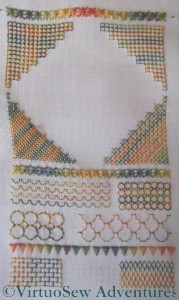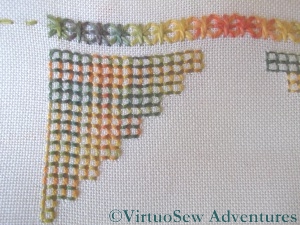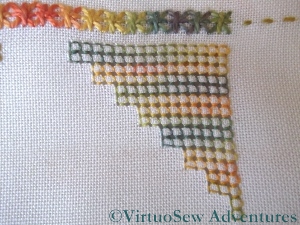A Pulled Work Sampler – First Installment
All my regular readers will know that while I’m very keen on experimenting with techniques that are new to me, I’m not so good at finishing what I’ve started.
I found this panel when I opened a box in the office that I’ve been ignoring for a while. I can’t even remember how long ago I started it, and you can see that although I worked it on a frame, it’s got somewhat out of shape while it’s been rolled up, because of the varying tension up and down the length of it. There’s less variation across the width, which strikes me as strange since I’m sure I used a roller frame, and didn’t tension the weftwise direction!
The sampler is worked using another pair of Caron Collection threads, the fine Wildflowers, and heavier Watercolours, in a bright orange and green overdye. I love the texture and colours of these threads, and they highlight the stitches beautifully. The fabric itself is Jobelan, which is a regular even-weave fabric, perhaps not quite sufficiently widely-sett for pulled work to show to its best advantage.
It occurs to me as I look at the photos that pulled work can be done with two different effects in mind – one using the pattern of stitches to create the effect, and the other using a much finer, self-coloured thread, creating the effect with the pattern of holes left by pulling the fabric threads together. Something else to try!
After beginning with a row of Star Stitches in the heavier thread, the first corner of the square panel is in Four Sided Stitch. What puzzles me about this is that the second section seems to be in the same stitch, whereas the two lower corners differ. It seems to me that this was a genuine sampler – I was making it up as I went along!




When I have done pulled thread I’ve always done the second method using a finer thread that blends. Colouring it looks great. Oh, and Rachel, love those words “I was making it up as I went along”. That’s life!
Nice pattern!
it’s lovely……and I am also a big fan of the Caron threads.
Anything pulled or counted and I simply do not agree, so I am in awe! This is lovely and the Caron threads are gorgeous!
Making it up as you go along is good! You get a chance to experiment a bit and see what you like and what you don’t. Will you continue with it … or hide it away again, though? xCathy
Oh, my very, very favorite threads are the Caron Wildflowers with the Watercolours right behind! Love, love, love the colors. Good for you – getting out an ‘oldie’ and readdressing it. I know we all have a few of those hanging around.
I have never used coloured threads to do pulled thread work. I wonder why? After seeing your piece I’m going to have to try that.
I don’t think it’s the same stitch at the top. On the right it’s normal 4sided, but on the left it’s done with all the stitches first in one direction and then the other. It would be interesting to see a close up of the back of that to figure out exactly which stitch you were doing. Nice piece of work – colour in pulled work needs to be used carefully, and this is very pleasing. I’m not surprised by the distortion. I don’t like Jobelan type cotton/acrylic fabric for pulled work because there’s a sort of stretchiness to it (from the acrylic), which does send it out of shape easily. (Cotton/rayon blends are fine – they don’t stretch.)
I’ve got it now. The right hand triangle is normal four sided in horizontal rows. The left hand triangle is one that is generally known as ‘punch stitch’ (although Moyra McNeil calls ‘mock faggot filling’ in Pulled Thread, if you have that book.) So that mystery is solved.
“while I’m very keen on experimenting with techniques that are new to me, I’m not so good at finishing what I’ve started” — I can guarantee you’re not alone in that! 😀
I love the thread on this, but I can’t quite tell: is it one thread with many colours, or are you alternating lots of different colours?
This has two great dimensions – the shapes of the stitches and the shading of the thread. I love the comment that you were making it up as you went along. Well, why on earth not?!! ;o)